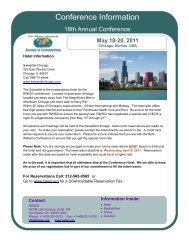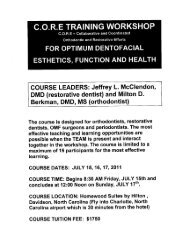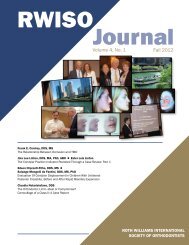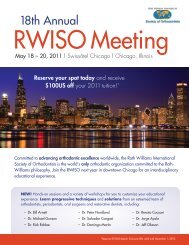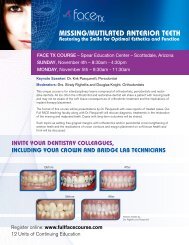2010 RWISO Journal - Roth Williams International Society of ...
2010 RWISO Journal - Roth Williams International Society of ...
2010 RWISO Journal - Roth Williams International Society of ...
You also want an ePaper? Increase the reach of your titles
YUMPU automatically turns print PDFs into web optimized ePapers that Google loves.
sure was first checked in the mounting on the true hinge ar-<br />
ticulator and then checked intraorally with and without the<br />
positioner. The patient was instructed to wear the positioner<br />
full time for the first 3 days (with the exception <strong>of</strong> eating and<br />
brushing). After the first 3 days, the patient was instructed to<br />
wear the positioner at night, with 4 hours <strong>of</strong> positioner exercise<br />
during the day. If the positioner should fall out during<br />
the night, the patient was instructed to wear the positioner<br />
for 6 hours during the day.<br />
Positioner Exercise and Wear Protocol<br />
The patient was instructed to bite into the positioner just<br />
enough to seat all <strong>of</strong> the teeth and to fully engage the teeth in<br />
the positioner. The patient was instructed to bite with pressure<br />
for about 10 seconds and then to relax for about 15<br />
seconds. The exercise was done in 15-minute intervals, with<br />
15 to 20 minutes <strong>of</strong> rest in between. For nighttime wear, the<br />
patient was instructed to put the positioner into the mouth<br />
and close the mouth to engage the positioner as much as possible<br />
without putting pressure on the positioner.<br />
The gnathologic positioner was checked for fit and arc<br />
<strong>of</strong> closure at 1, 2, and 4 weeks after delivery. After 2 months<br />
<strong>of</strong> positioner wear, postpositioner records were taken (time<br />
2). These consisted <strong>of</strong> the same records that had been taken<br />
at time 1. Upper splint and lower spring retainers were then<br />
delivered.<br />
The control group consisted <strong>of</strong> 8 randomly selected<br />
finished cases in the orthodontic clinic at the University <strong>of</strong><br />
Detroit Mercy. The control group was not preselected with<br />
regard to MI-CR discrepancy at debond. At the debonding<br />
appointment (time 1), braces were removed and records<br />
were taken. Upper and lower Hawley retainers were delivered,<br />
and the patient was instructed to wear them full time.<br />
After 2 months <strong>of</strong> Hawley retainer wear, records were taken<br />
again (time 2).<br />
MI-CR discrepancy was measured with a CPI (Panadent<br />
Corporation, Grand Terrace, California) at times 1 and 2 for<br />
both groups (Figure 4,5).<br />
Results<br />
The mean differences between MI and CR <strong>of</strong> the articulators’<br />
condylar axis position were recorded for the transverse,<br />
and separately for the right and for the left condyles in the<br />
vertical and anteroposterior (A-P) directions. Pre- and posttreatment<br />
measurements <strong>of</strong> MI-CR discrepancy <strong>of</strong> the control<br />
and positioner groups are summarized in Table 1.<br />
Figure 4 CPI registration with two-piece CR bite (A).<br />
CPI registration with MI bite (B). CPI Recording – transverse (C).<br />
CPI Recording – right (D).<br />
Figure 5 Condylar position indicator recording graph<br />
(CR – red dot, MI – blue dot).<br />
<strong>RWISO</strong> <strong>Journal</strong> | September <strong>2010</strong><br />
77



